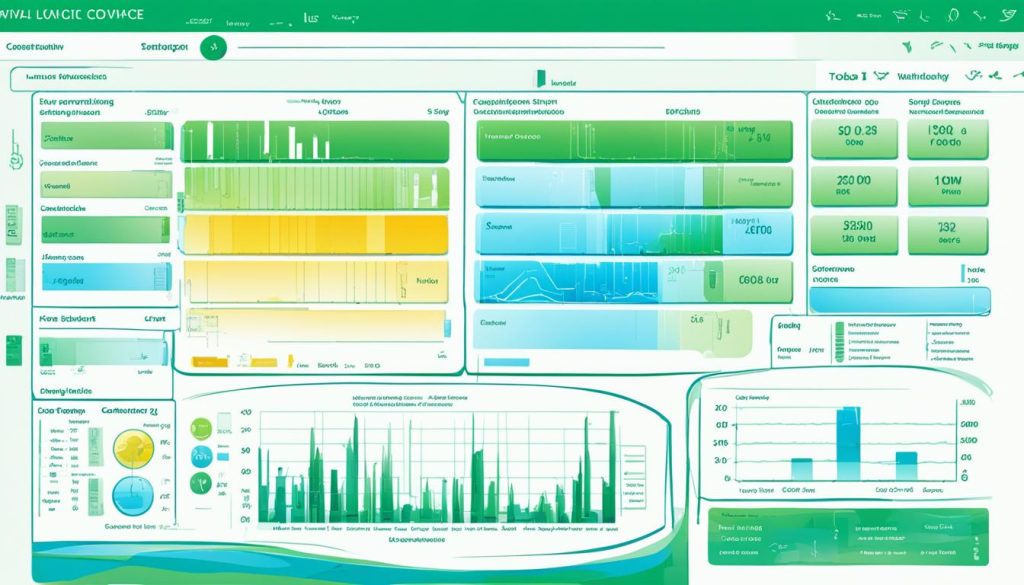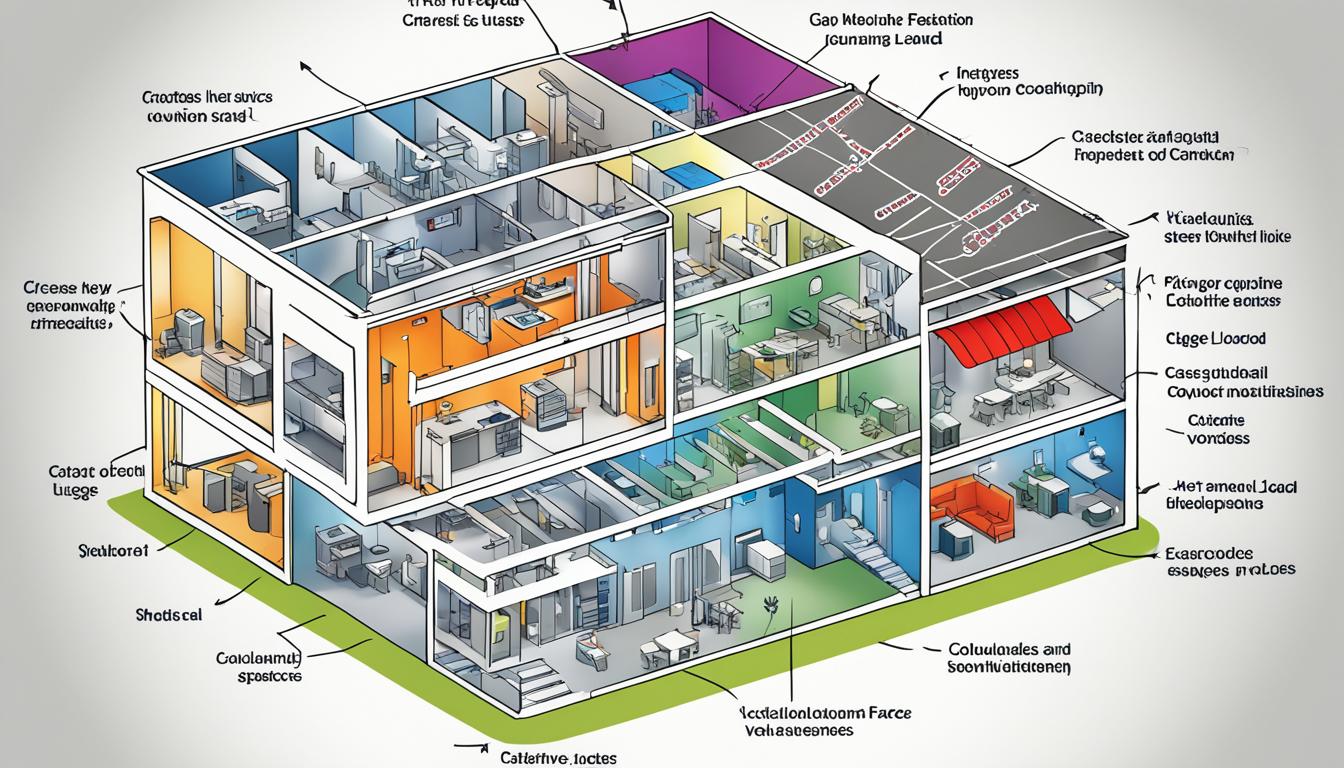Improving building energy efficiency starts with accurate HVAC load calculations. These calculations help design heating, ventilation, and air conditioning systems. They make sure these systems work well and use less energy.
Calculating HVAC load means figuring out how much heating or cooling your building needs. You must think about the climate, building design, insulation, how many people use the space, and the equipment. This ensures your HVAC system is the right size and uses energy efficiently.
Getting accurate load estimates helps pick the right equipment, improves comfort, and makes systems last longer. Learning about HVAC load calculations lets you create buildings that save money and are better for the environment.
Understanding HVAC Load Calculation Basics
HVAC load calculation is key to designing an effective HVAC system. It helps figure out the right size and capacity for heating, ventilation, and air conditioning in buildings. Let’s look at the basics of this process and why it’s important for saving energy.
Definition of HVAC Load Calculation
HVAC load calculation finds out how much heating and cooling a space needs. It looks at many factors that change the building’s temperature and comfort. This way, HVAC experts make sure the system is just the right size, avoiding inefficiency and high energy use.
Importance in Building Energy Efficiency
Getting load calculations right is key for saving energy in buildings. A system that’s the right size works well, cuts energy waste, and lowers bills. This careful design also means better air quality and comfort for people inside. Energy audits use these calculations to find ways to make buildings better.
Key Factors Influencing Load Calculations
Many things affect HVAC load calculations:
- Climate zone and local weather patterns
- Building size, shape, and orientation
- Insulation quality and building envelope tightness
- Window types and their U-values
- Occupancy levels and internal heat gains from equipment
- Lighting systems and their heat output
| Factor | Impact on Load Calculation |
|---|---|
| Climate Zone | Determines baseline heating and cooling needs |
| Building Envelope | Affects heat gain and loss through walls, roof, and floor |
| Windows | Influences solar heat gain and heat loss |
| Occupancy | Contributes to internal heat generation |
By looking at these factors, HVAC pros can design a system that fits each building perfectly. This ensures the system works great and saves energy.
The Impact of Accurate Load Calculations on Energy Efficiency
Getting the right HVAC load calculations is key to saving energy and building sustainably. By knowing exactly what your building needs for heating and cooling, you can make your HVAC system work better. This means you’ll use less energy and save money.
When your load calculations are correct, your HVAC system works perfectly. It uses just enough energy to keep you comfortable. This avoids wasting energy by cooling or heating too much. Systems that are the right size last longer and need less maintenance.
But, if your load calculations are off, you might end up with an HVAC system that’s too big or too small. A system that’s too big uses too much energy and doesn’t control humidity well. A system that’s too small can’t keep up, leading to high energy bills and discomfort.
Choosing precise load calculations helps optimize your HVAC system. This is good for the planet because it uses fewer resources and lowers environmental harm. Buildings with well-calculated HVAC loads have lower energy bills, happier people inside, and are worth more.
- Reduced energy consumption through right-sized equipment
- Improved indoor air quality and comfort levels
- Lower maintenance costs and extended system lifespan
- Compliance with energy efficiency standards and regulations
Using accurate load calculations is a wise choice for making buildings more efficient and green. It’s a smart move that helps owners, people living or working there, and the planet. It’s a win-win for everyone involved.
Essential Components of HVAC Load Calculation
Getting the right HVAC load calculations is key for saving energy and making buildings more efficient. To get it right, you need to look at several important parts. These parts help figure out the right size for your HVAC system and boost energy efficiency.
Climate and Geographical Considerations
Where your building is located matters a lot for load calculations. Things like climate zones, outdoor conditions, and elevation change the heating and cooling needs. For instance, a building in Miami has different needs than one in Seattle, affecting how much heat or cool air it needs.
Building Envelope Assessment
The building envelope is very important for load calculations. It includes walls, roofs, windows, and doors. You need to look at U-values, insulation, and how airtight it is. Getting this right helps save energy and keeps people comfortable.
Occupancy and Equipment Heat Gain
Things inside the building also add to the load. This is from people, lights, and machines. For commercial buildings, it’s key to know how many people and what equipment are there to get the calculations right.
Ventilation Requirements
Good ventilation is key for the air quality and comfort inside. The HVAC system must manage fresh air intake without wasting energy. You should think about how many air changes per hour and the quality of outdoor air.
| Component | Factors to Consider | Impact on Load Calculation |
|---|---|---|
| Climate | Temperature extremes, humidity, solar radiation | Determines peak heating and cooling loads |
| Building Envelope | Insulation, glazing, air leakage | Affects heat gain/loss through the structure |
| Internal Loads | Occupancy, lighting, equipment | Contributes to cooling load and affects heating needs |
| Ventilation | Fresh air requirements, air quality standards | Influences overall system capacity and energy use |
Tools and Methods for Performing HVAC Load Calculations
HVAC load calculations are key for designing efficient heating and cooling systems. There are many tools and methods to help you do these calculations right. Let’s look at some top choices.

Manual J is the top choice for figuring out HVAC loads in homes. It was created by the Air Conditioning Contractors of America (ACCA). This method helps you find out how much heating and cooling your home needs. While you can do it by hand, using software makes it easier and less prone to mistakes.
Energy audits are also crucial for getting the right data for load calculations. They use blower door tests to check how much air leaks out. Thermal cameras spot where insulation is missing. These tools help you see how well your building keeps in the heat or cold, which is key for load calculations.
| Tool/Method | Application | Benefits |
|---|---|---|
| Manual J | Residential load calculations | Industry standard, comprehensive |
| HVAC load calculation software | Both residential and commercial | Fast, accurate, easy to update |
| Blower door test | Air infiltration measurement | Precise air leakage data |
| Thermal imaging | Insulation assessment | Visual identification of heat loss areas |
For big projects, special software is used for HVAC load calculations. It follows ACCA rules and building codes. These programs let you quickly try out different designs and see how they save energy.
Common Mistakes in HVAC Load Calculations and How to Avoid Them
Getting HVAC load calculations right is key to saving energy. But, many errors come from wrong calculations. Let’s look at common mistakes and how to fix them for better accuracy.
Overestimating or Underestimating Loads
Many HVAC designs make the mistake of guessing loads wrong. Guessing too high means systems are too big, wasting energy and money. Guessing too low means they’re not enough, leaving people uncomfortable. Use the latest building info and smart tools to get it right.
Neglecting Building Orientation and Shading
How a building faces the sun affects how much heat it gets. Not thinking about this can mess up your calculations. Think about where the building is, what’s around it, and any trees or buildings that block the sun. These things are key to knowing how much heating and cooling you need.
Ignoring Internal Heat Gains
Things inside a building like people, lights, and machines add to the heat. Not counting on these can lead to wrong numbers. Always include all these heat sources in your calculations.
| Common Mistake | Impact | Solution |
|---|---|---|
| Load Misestimation | Energy waste or discomfort | Use updated data and tools |
| Ignoring Orientation | Inaccurate solar heat gain | Consider building position and shading |
| Overlooking Internal Gains | Underestimated cooling needs | Include all heat sources in calculations |
Avoiding these mistakes can make your load calculations more accurate. This leads to better HVAC system performance. Remember, getting the numbers right is crucial for saving energy in building design and use.
Improve Building Energy Efficiency with Load Calculations
Accurate load calculations are key to making your HVAC system energy-efficient. They help figure out what your building really needs for heating and cooling. This way, you can make your system work better and use less energy.
Starting with building performance optimization means knowing your building well. Load calculations look at things like insulation, window placement, and how often the building is used. This helps you find ways to save energy and make smart choices for upgrades.
Getting precise load calculations helps you avoid the wrong size HVAC systems. A system that’s too big uses too much energy and cycles too often. A system that’s too small can’t keep the space comfortable. The right size means your system works well and saves energy.
- Analyze building envelope for heat transfer points
- Consider local climate conditions
- Account for internal heat gains from occupants and equipment
- Evaluate ventilation requirements
Using sustainable HVAC practices with accurate load calculations saves a lot of energy. You’ll see lower bills, better air quality, and a smaller carbon footprint. By matching your HVAC system to your building’s needs, you make a more comfortable and efficient space for everyone.
Integrating Load Calculations into Building Design and Retrofits
Adding load calculations to building design and retrofits is key for the best energy use. This is important for both new and old buildings. It helps make buildings more energy-efficient and green.
New Construction Considerations
For new buildings, it’s vital to include load calculations early. These help decide on:
- Building orientation
- Insulation materials
- Window placement
- HVAC system sizing
Architects and engineers use these details to design buildings that use energy well. This makes new buildings meet high energy standards.
Retrofit Strategies for Existing Buildings
For old buildings, load calculations show where to make changes. Common upgrades include:
- Upgrading insulation
- Replacing old HVAC systems
- Installing energy-efficient windows
- Adding smart building controls
These changes make buildings use energy better and save money on bills.
Optimizing HVAC System Selection
Getting load calculations right is key for picking the best HVAC system. They make sure:
- Systems fit the building’s needs
- Energy use is low
- Indoor air stays comfortable
- Costs go down
This makes buildings use energy better and helps the planet.
| Project Type | Load Calculation Impact | Energy Efficiency Benefit |
|---|---|---|
| New Construction | Informs initial design decisions | Maximizes efficiency from the start |
| Retrofits | Identifies improvement areas | Enhances existing building performance |
| HVAC Selection | Ensures proper system sizing | Optimizes energy consumption |
Case Studies: Successful Energy Efficiency Improvements Through Accurate Load Calculations
Real-world examples show how precise HVAC load calculations lead to big energy savings and better system performance. Let’s look at two case studies. They show how detailed building energy modeling improves HVAC efficiency.
Commercial Office Building Retrofit
A 10-story office building in Chicago got a big HVAC upgrade. Engineers used advanced software for detailed load calculations. They found the old system was 30% too big.

- 25% less energy used each year
- $150,000 saved on energy costs annually
- Better temperature control for occupants
Residential Home Energy Upgrade
A single-family home in Atlanta got a full energy audit, including HVAC load calculations. The audit showed the air conditioning was too small for the home’s needs.
After getting a correctly sized HVAC system, the homeowners saw:
- 20% less on summer energy bills
- More even indoor temperatures
- Less humidity, making the home more comfortable
| Project | Energy Savings | Cost Savings | Comfort Improvement |
|---|---|---|---|
| Commercial Office | 25% | $150,000/year | Significant |
| Residential Home | 20% | $480/year | Notable |
These case studies prove that accurate HVAC load calculations are key. They help optimize system performance and save a lot of energy in both commercial and home settings.
Future Trends in HVAC Load Calculation and Energy Efficiency
The HVAC industry is changing fast, thanks to new technologies. These changes are making how we do load calculations and save energy better. Smart building systems are leading this change, giving us more control and ways to optimize.
Advancements in Calculation Software
New technologies are changing load calculation software. Now, artificial intelligence and machine learning help make predictions more accurate. These smart systems can change calculations as weather or how many people are in a building change.
Integration with Building Information Modeling (BIM)
BIM integration is changing the game for sustainable HVAC design. It combines load calculations with 3D building models. This lets engineers test different scenarios and improve system performance before building starts. It makes designs more efficient and cuts down on costly changes later.
Impact of Climate Change on Load Calculations
Climate change is making us rethink how we calculate loads. Designers now have to think about long-term weather trends and extreme events. This means designing systems that can handle the changing weather, keeping buildings comfortable and efficient.
Looking ahead, these trends will keep shaping the HVAC industry. By using smart building systems and focusing on sustainable design, we can make buildings that are resilient and use energy wisely. They will adapt to our changing world.
Conclusion
Getting HVAC load calculations right is key to better energy efficiency. It helps improve how buildings work. By sizing HVAC systems correctly, you get more energy savings and more comfort for people inside.
As buildings and the climate change, precise load calculations are more critical. Using new methods and tools is essential for energy-smart buildings. This supports sustainable HVAC practices, which are crucial for the future of building and renovating.
Every building is different. Customizing your HVAC system with careful load calculations makes a big impact. It’s not just about saving energy; it’s about making better, efficient spaces for everyone. By focusing on accurate HVAC load calculations, you’re moving towards a sustainable and comfortable future.





0 Comments